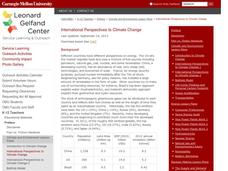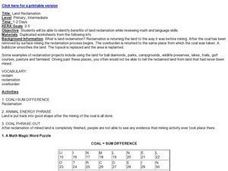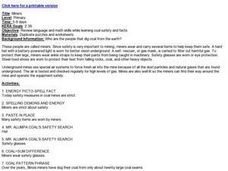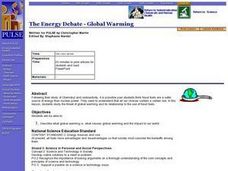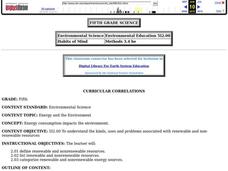Curated OER
Middle School Home Energy Audit
Seventh graders research the origins of local electrical power and compare costs and methods of generation with other areas of the country or world.
Carnegie Mellon University
How Power Plants Work 2
In this second of three lessons on power plants, future engineers find out how we generate electricity and how coal-powered plants operate. They work in small groups to make electromagnet generators to light LED bulbs. A set of...
Curated OER
Heat from Light
Second graders explore solar energy. For this science lesson, 2nd graders use hand lenses to see that light energy can be converted to heat energy.
Carnegie Mellon University
International Perspectives to Climate Change 1
After a lecture about how the first industrial revolution triggered the path to climate change, your environmental studies class discusses what the impacts are. In a culminating activity, they get into groups and identify countries on a...
Chicago Botanic Garden
Understanding the Greenhouse Effect
Dive into the power of the sun with a two-part lesson. Budding scientists model the greenhouse effect in a hands-on activity, and then participate in a skit that explores the earth's energy balances and what really occurs in the...
Curated OER
Land Reclamation
Students identify the benefits of the process of land reclamation. They discuss examples of reclamation projects, and complete a word puzzle, word find, and energy sentence puzzle.
Curated OER
Miners
Students complete various activities related to mining and mining safety. They write an energy sentence, complete a word puzzle, cut and glue safety equipment on a mining character, solve a math code word puzzle, and complete a maze...
Curated OER
When the Lights Go Out!
Students identify coal as the primary fuel used to generate electricity. After discussing coal's use in the generation of electricity, have students complete "When the Light Go Out" worksheet.
Curated OER
Solar Matters
Students design an energy resource wheel and demonstrate how to use it to access information about renewable and nonrenewable energy sources.
Curated OER
Powered Up About Electricity!
Students study the process of turning coal into electricity. In this electricity lesson, students are guided by their teacher through the steps required to turn coal into electricity. Students complete a worksheet answering questions...
Curated OER
It's All About Power
Students explore the legislative process by discussing a current issue dealing with energy policy. They explain the role of government and how it affects their quality of life. Students identify and list the groups that create energy...
Curated OER
How Much Does it Cost to Light Your School?
Learners explore the cost of electricity used to light their classrooms. They compute the cost of electricity as well as the number of kilowatt hours of electricity used during the school year. Students compute the number of tons of coal...
Curated OER
Turn On A Light And Do Your Own Revegetation
Students use electricity and plant a seed to observe the process when coal is the major fuel source to produce electricity. They use the packet of native seeds to experiment with revegetation.
Curated OER
Power In Variety
Students discover different types of energy. In this energy source instructional activity students compare different types of energy, renewable and nonrenewable. Students answer questions about the different types of energy and their...
Curated OER
Making New Electricity
Young scholars investigate the concepts of energy conversion and conservation. They research the history of energy conversions into electrical energy. They design experiments in order to replicate a conversion of energy into electricity.
Curated OER
Powering a Green Earth
Students compare and contrast renewable and nonrenewable energy. For this environmental science lesson, students discuss the importance of going green. They identify the different components in a power grid system.
Curated OER
Mississippi’s Electricity: From Generation to Consumption
Eighth graders discover how electricity is produced. For this physics lesson, 8th graders infer about the future of Mississippi's energy industry. They participate in a Smart Board interactive activity at the end of the lesson.
Curated OER
Don't Marry the Mole!
Third graders examine the power of solar energy. In groups, they create their own pizza box solar oven to discover the power of the sun and how it is a source for heat and light. To end the instructional activity, they use the internet...
Curated OER
The Energy Debate - Global Warming
Students describe what global warming is, what causes global warming and the impact to our world. They study the threat of global warming and its relationship to the use of fossil fuels.
Curated OER
Coal and Oil: Powering Our Way of Life
Students identify and represent some common products that are made using petrochemicals and some of the effects that higher gasoline and coal prices would have on the American economy in a graphical format. They synthesize information...
Curated OER
The Energy Debate - Sea Level Rise
Students comprehend the impact of global warming on our coastal cities. They appreciate how geographic information systems can be used to represent scientific data. Students research the melting of the ice caps in Antarctica and the Arctic.
Curated OER
Renewable vs. Non-Renewable Resources
Here's a fine lesson plan on renewable and non-renewable sources of energy for your 5th graders. In it, learners list a number of natural resources on the board, then try to sort the resources into appropriate categories. This helps them...
Curated OER
Windmill activity
Students explore how to build an efficient windmill design by taking into account how the lift and drag caused by the movement of wind can be used to make the blades of the turbine move. Through their readings, hypothesis and by trail...
Curated OER
Energy and the Environment
Fifth graders define terms associated with renewable and nonrenewable resources. They identify materials that are renewable and nonrewable. They categorize a list into the correct type of resource.



